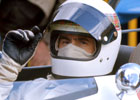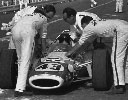11/6/1939
Record updated 10-Mar-08
Jackie Stewart is best known as a triple World Champion, but that pales in historical significance compared to his unfaltering campaign to improve safety and organisation in Grand prix racing.

Sir John Young Stewart, MBE was born in Milton, West Dunbartonshire. Better known as Jackie Stewart, and nicknamed The Flying Scot, he is a Scottish three-time Formula One racing champion. He is well-known in the United States as a commentator of racing television broadcasts where his Scottish accent made him a distinctive presence. Between 1997 and 1999 he was team principal in partnership with his son, Paul Stewart of the Stewart Grand Prix Formula One racing team.
Jackie's early involvement with cars was in the family business, Dumbuck Garage, in Milton, where he worked as an apprentice mechanic. His family were Jaguar dealers and had built up a successful practice. Jackie's father had been a motorcycle racer, and Jackie's brother Jimmy was a racing driver with a growing local reputation. He drove for Ecurie Ecosse and competed in the 1953 British Grand Prix, until he went off at Copse Corner in the wet. It was only natural that Jackie would soon become involved in motor racing like his older brother.
After his brother was injured in a crash at Le Mans the sport was discouraged by their parents and Jackie took up shooting. In target shooting Stewart made a name for himself and almost made it to the 1960 Summer Olympics, only just missing the team.
But he took up an offer from Barry Filer, a customer of his family business, to test in a number of his cars at Oulton Park. Stewart impressed all who were in attendance that day. Ken Tyrrell who was running the Formula Junior team for Cooper heard of this young Scotsman from a track manager and called up Jimmy Stewart to see if his younger brother was interested in a tryout. Jackie came down for the test and took over a car that Bruce McLaren was testing. McLaren at that time was already an experienced Formula One driver and the new Cooper F3 was a very competitive car in its class. Soon Stewart was besting McLaren's times, causing McLaren to return to the track for some quicker laps. Again, Stewart was faster and Tyrrell offered Stewart a spot on the team. This would be the beginning of a great partnership that would see them reach the pinnacle of the sport. But this was 1963 and Stewart still had a lot to learn.
In 1964 he drove in Formula Three for Ken Tyrrell and won his first race at Snetterton Motor Racing Circuit. Since Tyrrell did not compete in Formula One at that time, he joined BRM alongside Graham Hill in 1965. His first contract netted him £4,000. On his debut in South Africa he scored his first Championship point. Before the end of the year he won his first race at Monza. 1966 saw him almost win the Indianapolis 500 on his first attempt only to be denied by a broken scavenge pump while leading by over a lap with eight laps to go; however, Stewart's performance, having had the race fully in hand and sidelined only by mechanical failure, won him Rookie of the Year honours, the only occasion to date in race history that a rookie winner (Hill, team mate at Indianapolis as well, and final leader after Stewart) was deemed surpassed in performance by another first-timer.
Also, in 1966, a crash triggered his fight for improved safety in racing. In lap one of the 1966 Belgian Grand Prix at Spa-Francorchamps, when sudden rain caused many crashes, he found himself trapped in his BRM, getting soaked by leaking fuel. Any spark could cause a disaster. The marshals had no tools to help him, and it took his team mate Hill to get him out. Since then, a main switch for electrics and a removeable steering wheel became standard. Also, noticing the long and slow transport to a hospital, he brought his own doctor to future races, while the BRM team supplied a medical truck for the benefit of all.
In Formula One, he switched to Ken Tyrrell's team where he drove Matra chassis during the 1968 and 1969 seasons. His winning drive during the rain and fog of the 1968 German Grand Prix at the Nürburgring, where he won by a margin of four minutes, is considered as one of the finest ever, even though his rain tires were probably better than the ones of the competition.
Stewart became world champion in 1969 driving a Cosworth-powered Matra MS80. Up until September 2005 when Fernando Alonso in a Renault became champion, he was the only driver to have won the championship driving a French car. For the 1970 season, Matra insisted on using their own V12 engines, while Tyrrell and Stewart wanted to keep the Cosworth engines as well as the good connection to Ford Motor Company. As a consequence, the Tyrrell team bought a chassis from March Engineering, which Stewart drove with mixed success until Tyrrell built its own car later in the season. They were still sponsored by French Elf fuel company, and Stewart raced in a car painted in French Racing Blue for many years.
Stewart went on to win the Formula One world championship in 1971 and 1973 with Tyrrell cars. In the 1972 season he missed races due to Gastritis which was developed following frequent travelling, as Stewart also competed in the Can Am series with a Lola, and a Ford Capri in the touring car Group 2 European championship, with his F1 teamate François Cevert and other F1 pilots, at a time where the competition between Ford and BMW was at a climax.
His last and then record-setting 27th GP victory, came at the 1973 German Grand Prix at the Nürburgring with a convincing 1-2 for Tyrrell. After the fatal crash of his teammate François Cevert in practice for the 1973 United States Grand Prix at Watkins Glen, Stewart retired one race earlier than intended and missed what would have been his 100th GP.
Subsequently he became a consultant for the Ford Motor Company while continuing to be a spokesman for safer cars and circuits in Formula One.
Stewart covered NASCAR races and the Indianapolis 500 on American television during the 1970's and early 1980's, and has also worked on Australian TV coverage.
In 1997 Stewart returned to Formula One, with Stewart Grand Prix, as a team owner in partnership with his son, Paul. As the works Ford team, their first race was the 1997 Australian Grand Prix. The only success of their first year came at the rain-affected Monaco Grand Prix where Rubens Barrichello finished an impressive second. Reliablity was low however, with a likely 2nd place at the Nurburgring among several potential results lost. 1998 was even less competitive, with no podiums and few points.
However, after Ford acquired Cosworth in July 1998, they risked designing and building a brand-new engine for 1999. It paid off. The SF3 was consistently competitive throughout the season. The team won one race at the European Grand Prix at the Nurburgring with Johnny Herbert, albeit somewhat luckily, while Barrichello took three 3rd places, pole in France, and briefly led his home race at Interlagos. The team was later bought by Ford and became Jaguar Racing in 2000.

Jackie Stewart, After The Race

Jackie Stewart Matra F1 Silverstone

Jackie Stewart, March 701 Ford DFV 1970, Silverstone

Jackie Stewart, Silverstone

Jackie Stewart, Matra F2, Thruxton 1969.

Fuji, 1966. Jackie Stewart pits. (Johnson)